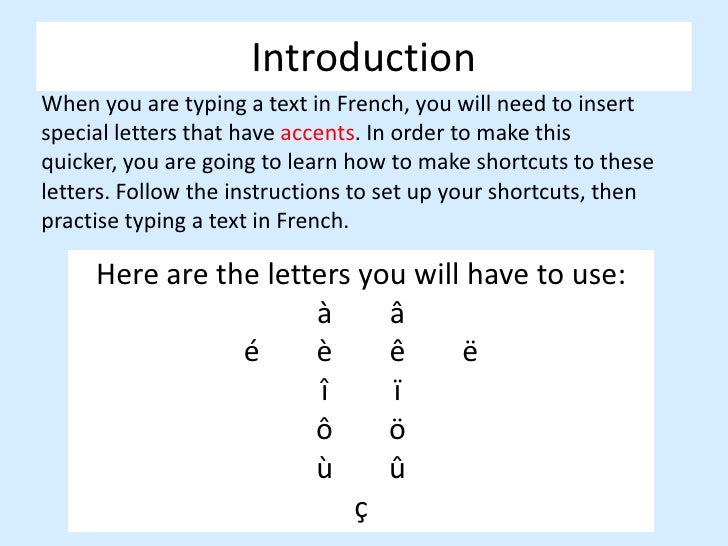Letters With Accents
30 rows ALT Codes for Foreign Language Letters with Accents Welcome to Useful Shortcuts, THE. Although Modern and Ancient Greek use the same alphabet, Ancient Greek uses 7 different diacritical signs (accents, breathings, etc.) that are placed over letters in various combinations. In Modern Greek, the number of diacritical signs has been reduced to 2 — the tonos ( ´ ) and the rarely used dialytika ( ¨ ). Spanish accents can be confusing – and I'm not just talking about the way they pronounce things in Chile. What about the written accent marks that go above Spanish letters? In Spanish, accent marks are important.
Using a word processor such as Microsoft Word
Using a word processor will probably be the easiest way to enter accents with your text, not only for compositions, but also for electronic messages that you can type first and then paste it into the CUBBoard. (You should also take advantages of your word processor's spelling checker—if a French dictionary is installed, it will check and correct your answers with your spelling).
Microsoft Word will allow you to insert characters with accents by clicking Insert-Symbol. Even better, however, are the keyboard shortcuts available since Word 97:

é: Press Ctrl and type '' (apostrophe). Release both keys and type 'e'.
à-è-ù: Press Ctrl and type '`' key (left-hand side, top of the keyboard). Release both keys and type 'e', 'a', or 'u'.
Accented Letters List
â-ê-î-ô-û: Press Ctrl and Shift and type '^' key. Release both keys and type 'a', 'e', 'i', 'o', or 'u'.

ç: Press Ctrl, and type ',' key. Release both keys and type 'c'.
ä-ë-ï-ü: Press Ctrl, Shift, and type ':' key. Release both keys and type 'a', 'e', 'i', or 'u'.
œ: Press Ctrl, Shift, and type '&' key. Release both keys and type 'o'.
Using Extended ASCII characters
If you need to write a message directly into Columbia's electronic bulletin board—if you are, for example, at a public terminal that does not have a word processor—you will need to use Extended ASCII codes to enter accents. (You can use Extended ASCII codes in a word processor such as Microsoft Word, but they are more complicated than Word's own codes). These characters are generated by holding down the 'ALT' key and typing in a three-digit numeric code with the numeric keypad on the right side of the keyboard. In addition, Windows also uses an extra system of keystrokes for entering these ASCII characters, which uses 'ALT' plus a four-digit numeric code. In a Windows application, either code can be used. For example, typing ALT + 130 or ALT+ 0233 will produce 'é':
â: ALT + 131 or 0226
à: ALT + 133 or 0224
ä: ALT + 132 or 0228
ç: ALT + 135 or 0231
é: ALT + 130 or 0233
è: ALT + 138 or 0233
ê: ALT + 136 or 0234
ë: ALT + 137 or 0235
î: ALT + 140 or 0238
ï: ALT + 139 or 0239
ô: ALT + 147 or 0244
ù: ALT + 151 or 0249
û: ALT + 150 or 0251
ü: ALT + 129 or 0252
œ: ALT + 0157
For a complete table of ASCII codes, see www.asciitable.com; for a table of Windows Extended ASCII codes, see http://www.waunakee.k12.wi.us/midlschl/ascii.htm
Using a built-in keyboard
You can switch the keyboard settings to reflect the standard French keyboard layout. You might want to use stickers to indicate which keys are which, since the French keyboard is somewhat different from the standard U.S. keyboard. Check your computer's Settings folder to see if this option is available.